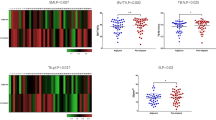Abstract
Micro-CT has successfully been applied to the characterization of false starts (FSs) and, among several parameters, kerf width seems to correlate to the tool blade. The aim of the present study was to evaluate the diagnostic value of micro-CT for the differentiation of saw marks produced by different classes of saws and by saws belonging to the same class and differing only in number of teeth per inches (TPI). A morphological and morphometric analysis of 84 marks, produced by 6 saws belonging to 3 morphological classes, was performed. In the experimental cohort, for each parameter, statistically significant differences in intra- and inter-class analysis were searched for and cut-offs were established. The diagnostic accuracy of cut-offs was assessed through statistical analyses on the validation cohort. The morphological assessment did not allow to differentiate saws differing only in TPI. Angle 1 and top kerf width, respectively for cross-cut and rip-cut saws with alternating set, allowed a good discrimination between FSs produced by tools belonging to the same morphological class. High positive predictive values were found in intra-class analyses, while results in inter-class analyses were less encouraging. In cases of dismemberment, a micro-CT-based analysis of FSs is strongly suggested as a part of a multistep and multimodal methodology of assessment, which includes scanning electron microscopy and stereomicroscopy. A morphological assessment should be followed by an experimental trial and by a morphometric analysis. Further studies are needed to evaluate hampering factors, such as damage by physico-chemical agents.




Similar content being viewed by others
References
Thali MJ, Taubenreuther U, Karolczak M, Braun M, Brueschweiler W, Kalender WA, Dirnhofer R (2003) Forensic microradiology: micro-computed tomography (micro-CT) and analysis of patterned injuries inside of bone. J Forensic Sci 48(6):1336–1342
Rutty GN, Brough A, Biggs MJ, Robinson C, Lawes SD, Hainsworth SV (2013) The role of micro-computed tomography in forensic investigations. Forensic Sci Int 225(1–3):60–66
Pelletti G, Viel G, Fais P, Viero A, Visentin S, Miotto D, Montisci M, Cecchetto G, Giraudo C (2017) Micro-computed tomography of false starts produced on bone by different hand-saws. Leg Med (Tokyo) 26:1–5
Pelletti G, Cecchetto G, Viero A, Fais P, Weber M, Miotto D, Montisci M, Viel G, Giraudo C (2017) Accuracy, precision and inter-rater reliability of micro-CT analysis of false starts on bones. A preliminary validation study. Leg Med (Tokyo) 29:38–43
Norman DG, Baier W, Watson DG, Burnett B, Painter M, Williams MA (2018) Micro-CT for saw mark analysis on human bone. Forensic Sci Int 293:91–100
Bailey JA, Wang Y, van de Goot FR, Gerretsen RR (2011) Statistical analysis of kerf mark measurements in bone. Forensic Sci Med Pathol 7(1):53–62
Saville PA, Hainsworth SV, Rutty GN (2007) Cutting crime: the analysis of the “uniqueness” of saw marks on bone. Int J Legal Med 121(5):349–357
Nogueira L, Quatrehomme G, Rallon C, Adalian P, Alunni V (2016) Saw marks in bones: a study of 170 experimental false start lesions. Forensic Sci Int 268:123–130
Bonte W (1975) Tool marks in bones and cartilage. J Forensic Sci 20:315–323
Capuani C, Guilbeau-Frugier C, Delisle MB, Rougé D, Telmon N (2014) Epifluorescence analysis of hacksaw marks on bone: highlighting unique individual characteristics. Forensic Sci Int 241:195–202
Nogueira L, Alunni V, Bernardi C, Quatrehomme G (2018) Saw marks in bones: a study of “secondary features” of false start lesions. Forensic Sci Int 290:157–161
Symes SA, Chapman EN, Rainwater CW, Cabo LL, Myster SMT (2010) Knife and saw toolmark analysis in bone: a manual designed for the examination of criminal mutilation and dismemberment. Available at: https://www.ncjrs.gov/pdffiles1/nij/grants/232227.pdf
Baier W, Norman DG, Warnett JM, Payne M, Harrison NP, Hunt NCA, Burnett BA, Williams MA (2017) Novel application of three-dimensional technologies in a case of dismemberment. Forensic Sci Int 270:139–145. https://doi.org/10.1016/j.forsciint.2016.11.040
Freas LE (2010) Assessment of wear-related features of the kerf wall from saw marks in bone. J Forensic Sci 55(6):1561–1569
Giraudo C, Fais P, Pelletti G, Viero A, Miotto D, Boscolo-Berto R, Viel G, Montisci M, Cecchetto G, Ferrara SD (2016) Micro-CT features of intermediate gunshot wounds covered by textiles. Int J Legal Med 130(5):1257–1264
Marciniak S (2009) A preliminary assessment of the identification of saw marks on burned bone. J Forensic Sci 54(4):779–785
Kooi RJ, Fairgrieve SI (2013) SEM and stereomicroscopic analysis of cut marks in fresh and burned bone. J Forensic Sci 58:452–458
Cecchetto G, Giraudo C, Amagliani A, Viel G, Fais P, Cavarzeran F, Feltrin G, Ferrara SD, Montisci M (2011) Estimation of the firing distance through micro-CT analysis of gunshot wounds. Int J Legal Med 125(2):245–251
Funding
This project received funding by the Department of Cardio-Thoraco-Vascular Sciences and Public Health, DOR1884238 of the University of Padova.
Author information
Authors and Affiliations
Corresponding author
Ethics declarations
All the experiments performed in the study comply with the current Italian laws and the local ethical rules. The bones used in the experiment were collected from limbs surgically amputated for medical reasons; this material does not belong to the subject after amputation (no informed consent necessary) and can be used for scientific experiments after approval of the Ethical Committee (Ethical Committee of the University-Hospital of Padua: Protocol n. 2013P).
Conflict of interest
The authors declare that they have no conflict of interest.
Additional information
Publisher’s note
Springer Nature remains neutral with regard to jurisdictional claims in published maps and institutional affiliations.
Rights and permissions
About this article
Cite this article
Giraudo, C., Montisci, M., Giorgetti, A. et al. Intra-class and inter-class tool discrimination through micro-CT analysis of false starts on bone. Int J Legal Med 134, 1023–1032 (2020). https://doi.org/10.1007/s00414-019-02157-3
Received:
Accepted:
Published:
Issue Date:
DOI: https://doi.org/10.1007/s00414-019-02157-3




